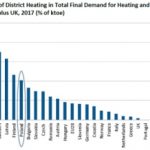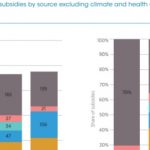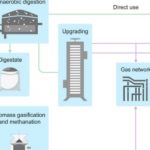Many industries – production of steel, aluminium and cement being the most obvious – require high heat processes that today can only be achieved commercially using fossil fuels. Paige Bennett at EcoWatch, writing for WEF, describes a new process using solar thermal trapping to reach temperatures of a little over 1,000°C, hot enough to smelt metal. Scientists used semi-transparent materials, including synthetic quartz, to capture sunlight that … [Read more...]
New Concentrated Solar Power system delivers 1,000°C for industrial processes + more
Zach Winn at MIT describes a new method of building high-temperature concentrated solar power systems. The solar receiver heats air to around 1,000°C at atmospheric pressure. The system circulates the hot air with no combustion or emissions to drive a turbine. The system can deliver daytime power and overnight thermal energy storage to provide round-the-clock power. More interestingly, it can provide industrial-grade heat. It’s being … [Read more...]
Batteries made of super-hot sand: for long-duration grid storage at $4 to $10 per kWh
Our electric future needs low-cost long-duration storage for grids. Per kWh, pumped hydropower is about $60, compressed air energy storage (CAES) costs from $150 to $300, and lithium-ion batteries cost around $300 (and only store energy from one to four hours). Wayne Hicks at NREL describes research into thermal energy storage (TES) using solid particles such as sand which is abundant worldwide. With a duration lasting hundreds of hours, … [Read more...]
IPCC AR6 report reveals a bigger impact at lower temperatures than previously predicted: health, crops, species loss +more
Published in March, the IPPC’s AR6 Synthesis Report on Climate Change updates its predictions of the effects of temperature rises. It starkly concludes that those temperature rises will have a bigger impact at lower temperatures than previously predicted. Charlotte Edmond, writing for the World Economic Forum, picks out five charts from the report to illustrate the point: the range of likely temperature rises; global map of change in temperature, … [Read more...]
Canada to tap Dormant Volcanoes for Geothermal energy
Live volcanoes might be an obvious source of geothermal energy if it wasn’t for the fact they were dangerous. But dormant volcanoes aren’t, yet they still host vast reservoirs of natural heat near the Earth’s surface. So Canada is looking to generate power from Mount Meager and Mount Cayley, two dormant volcanoes north of Vancouver, explains Lizzy Rosenberg writing for the World Economic Forum. Although Canada isn't known for its volcanoes, its … [Read more...]
Deep Geothermal: accessing 500°C for steam turbines. Can it make coal, gas, nuclear redundant?
The concept of “deep geothermal” is very simple. Dig deep enough, like 20km, to access a permanent reservoir of 500°C of heat. There, you generate the steam to power your turbines. The digging of a stable hole and getting the steam to the turbine is the big engineering challenge. But if you find a way that allows you to do it anywhere in the world (i.e. not limiting yourself to existing geological formations), nobody will ever need other … [Read more...]
New thermophotovoltaic cells turn heat into electricity more efficiently than a steam turbine
Over 90% of the world’s electricity comes from heat-generating power plants using coal, natural gas, nuclear energy, and concentrated solar energy. Steam turbines have always been the standard for converting that heat into electricity. On average they are only 35% efficient, with moving parts that cannot cope with temperatures above 2,000 degrees Celsius. Jennifer Chu at MIT describes new research, in collaboration with NREL, that has led to a … [Read more...]
How a street can share a Ground Source Heat Pump
Ground and air source heat pumps are expected to play a major role in cutting the use of gas for heating. But one major problem with them is that they need a lot of space. For those living in dense housing it’s just not practical. District heat networks are the usual alternative, but the dense urban areas they serve need to be near a large source of waste heat like power stations or other industrial units. David Barns at the University of Leeds … [Read more...]
Getting Concentrated Solar Power (CSP) down to $0.05 per kWh
The U.S. Department of Energy is funding research to get the cost of Concentrated Solar Power (CSP) down to $0.05 per kWh. One key element of that research is the materials used to absorb and store the heat energy. Three categories of materials are being looked at: liquid (i.e. molten salt), particle (like sand), and gaseous. NREL is leading the molten salt research, and there are multiple challenges. The salts can corrode the storage tanks and … [Read more...]
Redesigning UK electricity taxes to boost Heat Pump sales
In the UK, consumer prices for electricity are five times more expensive than for gas. It is a disincentive to adopt electric heat pumps. To make things harder, 23% of the electricity price comes from climate and social levies. It’s just 2% for gas. No wonder the UK continues to install about 1.7 million gas boilers a year. Jan Rosenow and Richard Lowes at RAP call for changes that will incentivise customers to buy heat pumps while having a … [Read more...]
Waste Heat Recovery can help replace Poland’s District Heating coal
Three quarters of all district heating in Poland comes from burning coal. So the country is looking for ways to reduce this. It’s why subsidies are provided for combined heat and power (CHP) plants that burn either coal, gas or biomass, which all have lower emissions. But a report by IEEFA authored by Gerard Wynn, Arjun Flora and Paolo Coghe says that waste heat recovery (WHR) – currently unsubsidised – is both emissions free and can be … [Read more...]
Investing for tomorrow, because Energy subsidies will decline 25% by 2050 – analysis
IRENA has modelled energy subsidies to 2030 and 2050 for their pathway to meet the Paris targets. Here, Michael Taylor summarises their findings. Firstly, they estimate today’s global direct energy sector subsidies to be $634bn/year (2017 figures). The vast majority, $447bn, went to fossil fuels. (By the way, he points out that none of these figures include the externality costs - pollution, healthcare, environment - which equate to trillions and … [Read more...]
Green Ammonia can replace fossil fuel storage at scale
What’s the best way to store energy, from industry scale to electric vehicles, replacing the widespread use of fossil fuels? Pure hydrogen is an energy dense alternative, but the gas takes up a lot of space. Liquid ammonia doesn’t, yet it contains the hydrogen and therefore the energy. Ian Wilkinson at Siemens explains the advantages of using ammonia, NH3. Already the world produces 180m tonnes a year, worth €80bn. It’s mainly for agricultural … [Read more...]
Biogas and Biomethane’s untapped potential across the world
The IEA’s World Energy Outlooks have no doubt that electrification alone cannot meet our climate goals. That’s why natural gas continues to play a major role. But biogas and biomethane have the potential to replace 20% of that gas, says the IEA’s special report “Outlook for biogas and biomethane: Prospects for organic growth”. At present only a fraction of that is being utilised. Here the IEA summarises their comprehensive report. Costs are the … [Read more...]















